DaoCloud Enterprise 5.0¶
DaoCloud Enterprise 5.0 (DCE 5.0) is an advanced and highly scalable cloud native operating system designed to provide a consistent and reliable experience across diverse infrastructures and environments. With support for heterogeneous clouds, edge clouds, and multicloud management, DCE 5.0 offers unparalleled flexibility.
By seamlessly integrating state-of-the-art service mesh and microservice technologies, DCE 5.0 enables comprehensive tracking of the entire traffic lifecycle. Users can gain valuable insights into detailed metrics related to clusters, nodes, applications, and services. Visualizing the health status of applications through dynamic dashboards and topology maps empowers users with actionable information to optimize performance.
A major advantage of DCE 5.0 is its native support for the DevOps development and operation mode, facilitating standardization and automation throughout the application delivery process. Additionally, DCE 5.0 effortlessly integrates a range of carefully selected databases and middleware, enhancing operational efficiency and governance. Each product module operates independently, ensuring flexible upgrades without disrupting critical business operations. Furthermore, DCE 5.0 seamlessly integrates with various cloud native ecosystem products, forming a comprehensive and robust solution system.
With extensive testing from thousands of industry customers in real production cases, DCE 5.0 has established itself as a solid and trustworthy digital foundation. It assists enterprises in defining their digital boundaries and unleashing the full potential of cloud native productivity. Embrace DCE 5.0 to elevate your organization's capabilities in the cloud native landscape.
- Install Installation instructions
- Workbench CI/CD pipeline
- Container Management Cluster/node/workloads
- Multicloud Management Multicloud instance/workload/policy
- Container Registry Integrate and host registries
- Network Multi-CNI fusion solution
- Storage Containerized storage
- Virtual Machine Containerized virtual machine
- Insight One-stop graphical dashboard
- Microservice Engine Microservice governance and gateway
- Service Mesh Non-intrusive service governance
- Middleware ES, Kafka, MinIO, MySQL, etc.
- AI Lab Cloud Native AI - Integrated Training and Inference Platform
- Cloud Edge Collaboration Containers extend to edge
- Global Management Login/permissions/appearance
- Free Trial

Over the past ten years, DaoCloud has made significant investments to explore and develop a cloud native operating system with customizable and scalable modules that facilitate business digitalization. Each module can be used as a LEGO brick, allowing for zero downtime while upgrading any module. DCE 5.0 is also easy to integrate with hundreds of cloud native ecological plugins, making it simple to customize solutions for various use cases. This modular style allows for continuous growth, improving over time.
DCE 5.0 provides cloud native computing, networking, storage, and other capabilities, compatible with various cluster access. It supports the entire lifecycle of the cluster from deployment, version upgrades, certificate changes, configuration changes, and recycling, enabling lifecycle management.
This capability breaks through K8s API performance bottlenecks, allowing large-scale enterprise users to use multiple clusters concurrently. Additionally, for the enterprise environment, it provides scenario-based network solutions to maximize the reuse of current enterprise network infrastructure and lower the threshold for enterprises to adopt cloud native applications.
- About Cloud Native Computing: Abstracts underlying infrastructure to support upper-layer applications and other modules, including computing and storage.
- About Cloud Native Networking: Adapts to various overlay and underlay network environments, supporting multiple network modes like Spiderpool, Cillium, Macvlan, and Multus.
- About Cloud Native Security: Integrates RBAC permission authentication systems to safeguard operational security.
Related modules: Global Management, Container Management, Cluster Lifecycle Management, cloud native network, cloud native storage
DCE 5.0 supports unified and centralized management of multicloud and hybrid clouds, providing cross-cloud resource retrieval and application deployment, release, and operation and maintenance capabilities. This enables efficient management and control of multicloud applications, scaling of applications based on cluster resources, and global load balancing.
Furthermore, DCE 5.0 offers fault recovery capabilities that effectively solve the problem of multicloud application disaster recovery, helping enterprises build robust multicloud and hybrid cloud digital infrastructure.
Modules involved: Global Management, Container Management, Multicloud Management, cloud native network, cloud native storage, Heterogeneous architecture
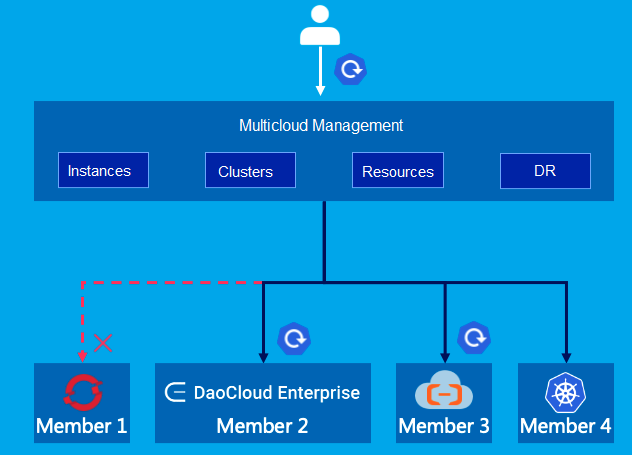
The cloud native local storage capability, specially designed for stateful applications, meets the high I/O storage requirements of middleware and improves the efficiency of operation and maintenance management. It offers middleware management capabilities for the entire lifecycle of multi-tenancy, deployment, observation, backup, operation, and maintenance operations, among others.
This capability supports various middleware such as databases, distributed messages, log retrieval, enabling self-service application, elastic expansion, high concurrent processing, and high stability and availability of data services.
Related modules: Global Management, Container Management, Cloud Native Network, cloud native storage, selected middleware

DCE 5.0 provides non-intrusive traffic management features, supporting non-sensing access to traditional microservices, cloud native microservices, and open-source microservice frameworks. It achieves integrated management of existing microservice systems and new and legacy microservice systems of enterprises.
This capability supports the lifecycle management of microservices from development, deployment, access, observation, operation, and maintenance. It also provides high-performance cloud native microservice gateways, ensuring continuous availability of microservice applications. Additionally, DCE 5.0 introduces independent open-source eBPF mesh acceleration technology to comprehensively improve traffic forwarding efficiency.
Related modules: Global Management, Container Management, Microservice Engine, Service Mesh, Observability, Workbench, Cloud Native Network, Cloud Native Storage
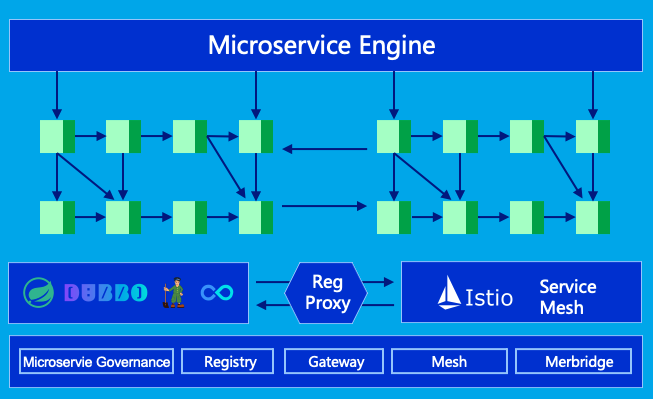
DCE 5.0 comprehensively collects service data based on logs, traces, metrics, eBPF, and other technical means. It acquires detailed request link information and dynamically observes and multi-dimensionally controls real-time changes in clusters, nodes, applications, and services.
This capability enables the querying of all clusters and observation of load data through a unified control plane. Additionally, it introduces topology analysis technology to visualize the application health status and achieves second-level fault location.
Modules involved: Global Management, Container Management, Observability, cloud native network, cloud native storage
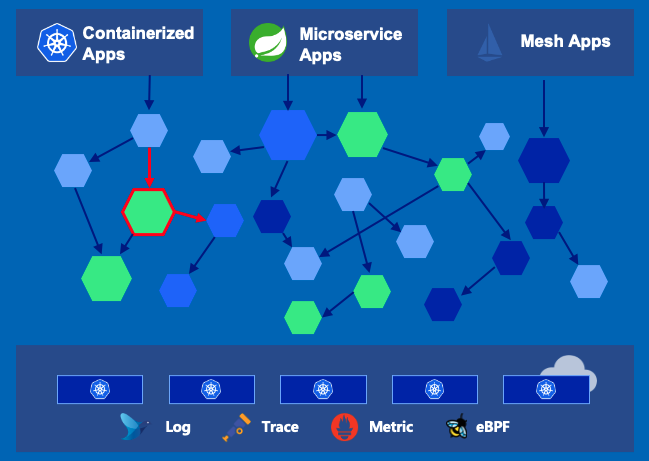
DCE 5.0 includes software products from ecological partners in ten major fields, such as big data and AI, middleware, etc. This enables the integration of ecological technology, products, operation services, and other capabilities. Additionally, it provides out-of-the-box ecological application software, creating a complete solution system.
Related modules: Global Management, Container Management, Cloud Native Network, cloud native storage, app store, product ecology
DCE 5.0 realizes self-service migration to the cloud through a consistent and scalable app delivery process. It supports flexible tenant systems, dynamically adapting to user organizational structure planning and real-time resource allocation.
This capability is based on cloud native CI/CD pipelines, integrating rich toolchains, and supporting efficient concurrent execution flow. Additionally, it automates the construction and deployment of applications, innovatively introducing GitOps and progressive delivery capability systems, achieving more refined management and operation of applications.
Modules involved: Global Management, Container Management, Workbench, container registry, cloud native network, cloud native storage
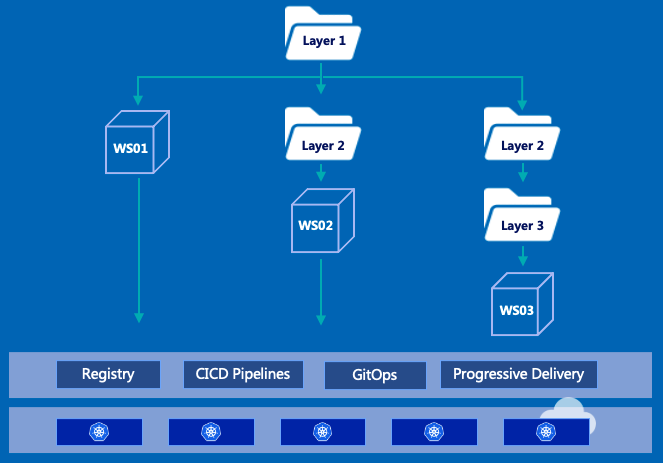
DCE 5.0 adopts a heterogeneous cloud native technology architecture, compatible with domestic chips and servers. It supports a heterogeneous operating system and application ecosystem, shielding the complexity of underlying heterogeneous infrastructure, and liberating traditional operating systems from the need for long-term software ecological compatibility.
This capability realizes the flexible scheduling of mixed heterogeneous clusters, ensuring the stability and reliability of the heterogeneous application operating environment. Furthermore, it helps speed up the heterogeneous process.
Related modules: Global Management, Container Management, Cluster Lifecycle Management, Middleware, Cloud Native Network, Cloud Native Storage
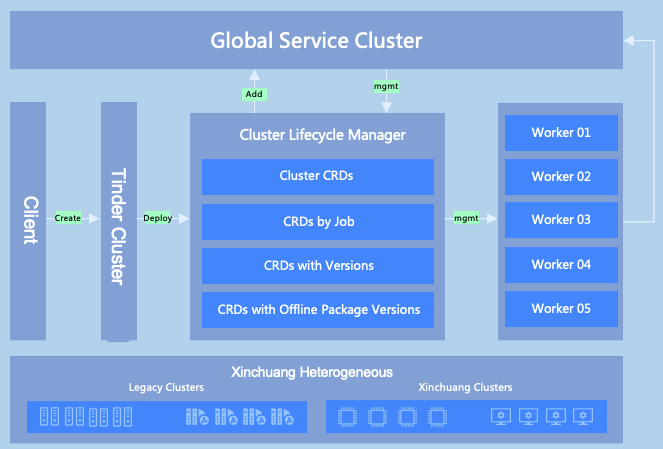
DCE 5.0 extends cloud native capabilities to the edge by adopting the edge cluster and edge node mode. It moves the computing power of the data center down, while elevate the computing power of the end device. This unifies control and scheduling of discrete and heterogeneous computing resources, solving the problem of massive edge and end devices.
This capability unifies the requirements of large-scale app delivery, operation and maintenance, management, and control on the Internet. Additionally, it realizes true integration of cloud and edge by bringing cloud native capabilities to the edge.

Based on KubeVirt technology, virtual machines are managed as cloud native applications, seamlessly integrated with containers, allowing users to easily manage the entire lifecycle of virtual machines, including capabilities such as snapshots, recovery, cloning, and live migration. Users can enjoy a smooth experience similar to container applications.
Modules involved: Global Management, Container Management, Cloud Native Networking, Cloud Native Storage
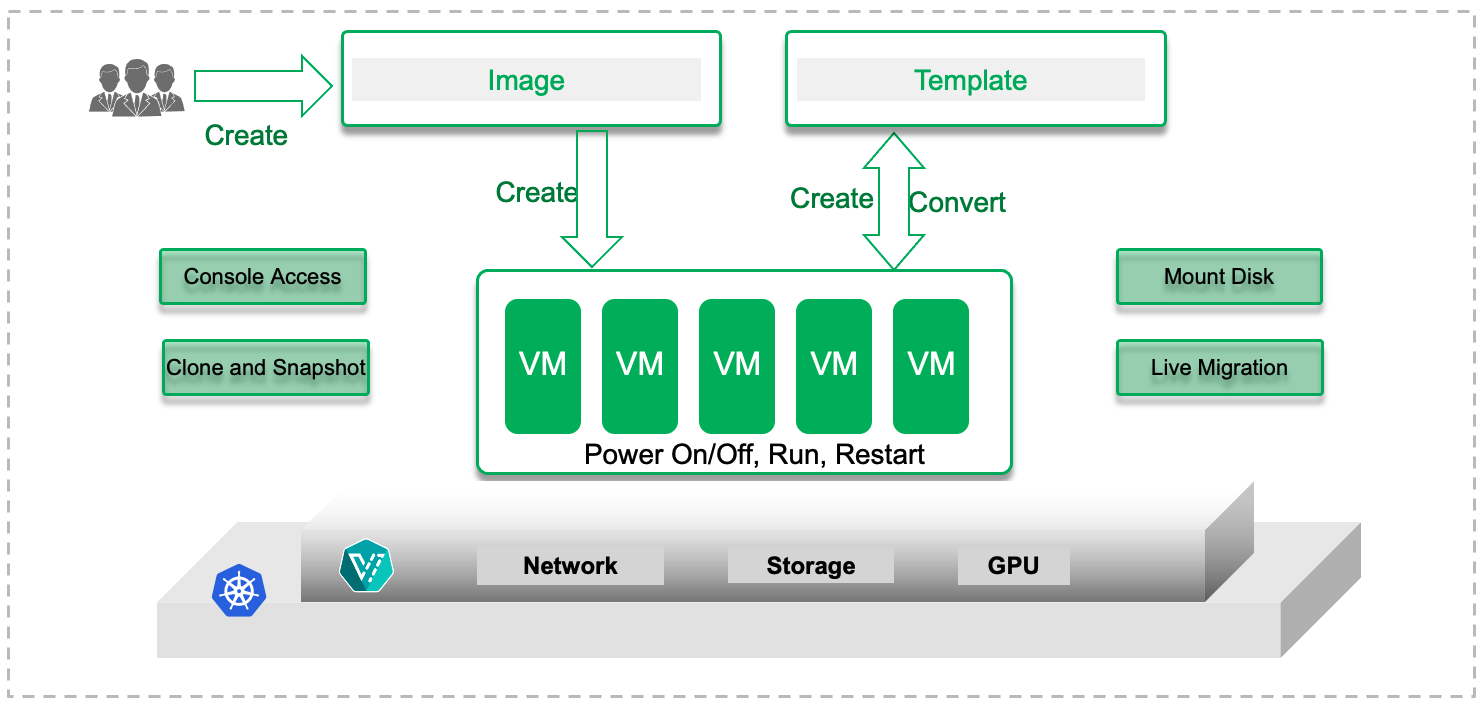
Integrate MLOps and large language models (LLMs) seamlessly into a cloud-native platform to create a comprehensive AI AI Lab solution with an end-to-end R&D lifecycle. This platform supports a variety of deep learning frameworks, including PyTorch and TensorFlow, and offers capabilities for dataset management, model development, training, inference, monitoring, and operations. Users can concentrate solely on developing and deploying models, without the need to manage underlying resource scheduling, administration, or monitoring tasks.
Modules involved: Global Management, Container Management, Cloud Native Networking, AI Lab

Once you have obtained the license authorization and successfully logged into DCE 5.0 for the first time, you will be greeted by a user-friendly dashboard. This dashboard provides an intuitive display of various information, including the status of running containers and pods, CPU and memory usage, health status of clusters/nodes/pods, alerts, resource utilization, and an overview of available functionalities.
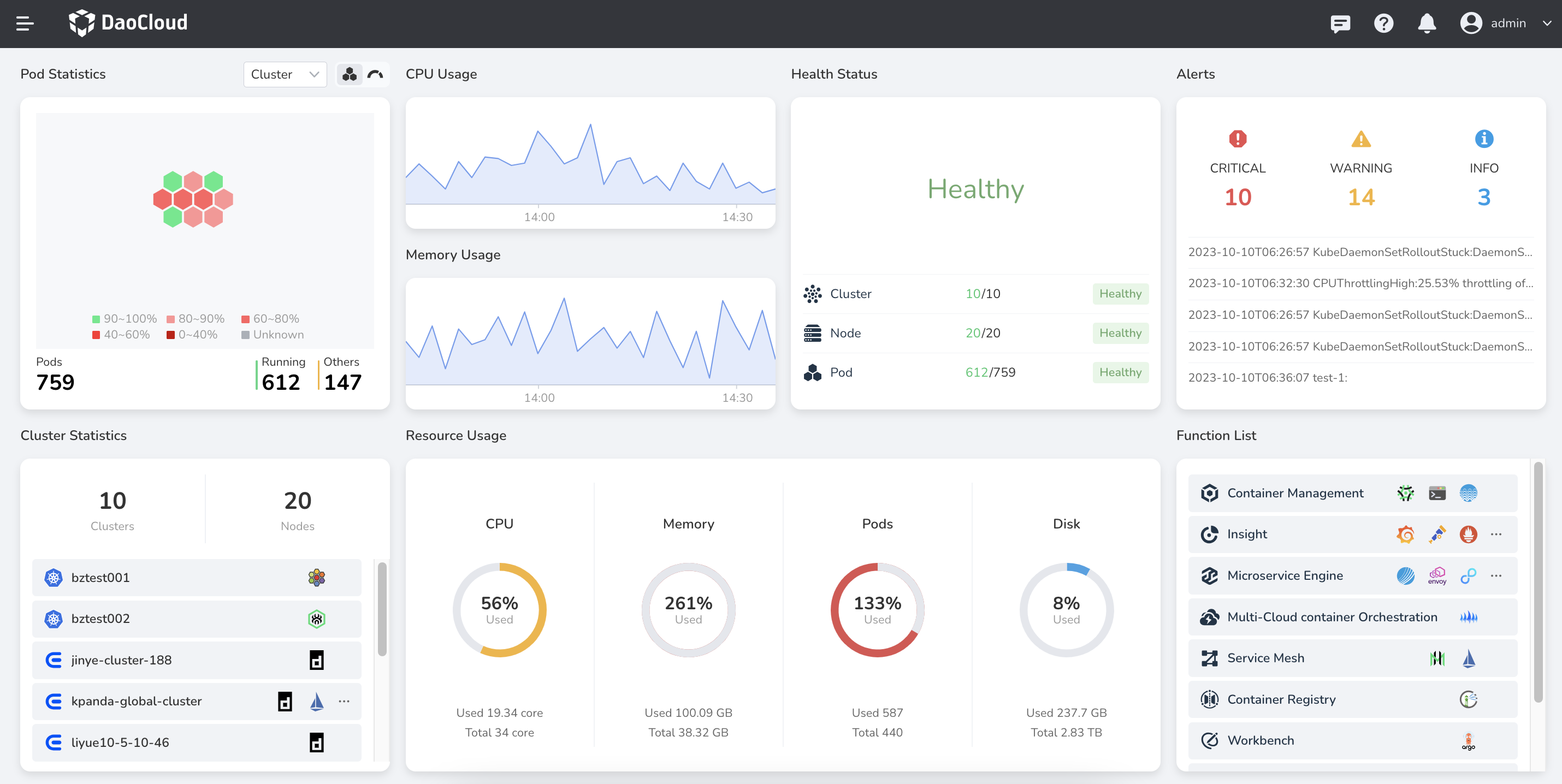
Download DCE 5.0 Install DCE 5.0 Free Trial
